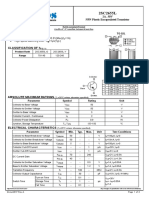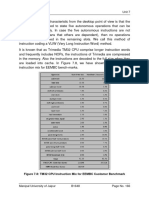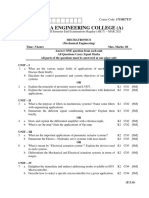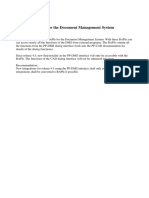Final Exam: Question 1 (L.O.2) (2.0pts.) : Node-Voltage Method
Final Exam: Question 1 (L.O.2) (2.0pts.) : Node-Voltage Method
Uploaded by
Pham Lê HuyCopyright:
Available Formats
Final Exam: Question 1 (L.O.2) (2.0pts.) : Node-Voltage Method
Final Exam: Question 1 (L.O.2) (2.0pts.) : Node-Voltage Method
Uploaded by
Pham Lê HuyOriginal Title
Copyright
Available Formats
Share this document
Did you find this document useful?
Is this content inappropriate?
Copyright:
Available Formats
Final Exam: Question 1 (L.O.2) (2.0pts.) : Node-Voltage Method
Final Exam: Question 1 (L.O.2) (2.0pts.) : Node-Voltage Method
Uploaded by
Pham Lê HuyCopyright:
Available Formats
(Date) (Date)
Lecturer: Approved by:
(Signature & Fullname) (Signature, Position & Fullname)
(The above part must be hidden when copying for exam)
Semester/Academic year 2 2019-2020
FINAL EXAM Date 23/07/2020
Course title Introduction to Electrical and Computer Engineering
UNIVERSITY OF TECHNOLOGY - VNUHCM Course ID EE1029
FACULTY OF EEE Duration 90 mins. Question sheet code
Notes: Answer on this question sheet.
Lectures, class notes, books, laptops, iPads, iPhones, etc. are NOT allowed.
Arithmetic-only calculators are accepted.
Show all your work, e.g., your solution process, the equation(s) that you use, the values of the
variables used the equation(s), etc.
Include the unit of measurement in each answer.
Do NOT communicate with any other students.
Exam supervisor 1 (Signature & Fullname) Exam supervisor 2 (Signature & Fullname)
Score:
Question 1 (L.O.2) (2.0pts.): Node-voltage Method
The voltages V1, V2, V3, and V4 are the node voltages corresponding to nodes 1, 2, 3, and
4 in figure below. Use the node-voltage method to determine the values of these node
voltages.
Stu.ID: ......................................... Stu. Fullname: ............................................................................................................ Page 1/4
Question 2 (L.O.2) (2.0pts.): Thévenin & Norton Equivalent Circuits
Find the Thévenin equivalent circuit with respect to the terminals a,b for the circuit below.
RTH
a
+
VTH 2.0kΩ
12 V RL
VA
1.0kΩ
R1
-
b
1. (1.5 pts.) By finding the open-circuit voltage and the short-circuit current.
2. (0.5 pts.) Solve for the Thévenin resistance (RTH) by removing the independent
sources.
Question 3 (L.O.3) (1.5pts.): Diodes
Use the ideal diode model to determine the state (ON or OFF) of each diode (D1, D2).
Stu.ID: ......................................... Stu. Fullname: ............................................................................................................ Page 2/4
Question 4 (L.O.3) (1.5pts.): BJT
Given BJT parameters: VBEON= 0.7V; β= 100; VCESAT = 0.2V
1. (1.0 pts) Determine IB, IC, IE, VCE and the state of BJT.
Note that use the equation IE = IB + IC for calculating the IE current.
2. (0.5 pts) Determine the power dissipated in BJT.
Question 5 (L.O.4) (1.0pts.): Number system conversion
Convert the hexadecimal number 605.B4 to decimal number.
1. (0.5pts) From hexadecimal number:
2. (0.5pts) From binary number:
Stu.ID: ......................................... Stu. Fullname: ............................................................................................................ Page 3/4
Question 6 (L.O.4) (1.0pts.): Basic Boolean Algebra Identities
Using Boolean identities, prove that C D B .C A BD A C B C B D
Question 7 (L.O.4) (1.0pts.): Basic Logic Gates
Given the logic circuit below.
A
B
C F
1. (0.5 pts) Determine the truth table for F(A,B,C).
A B C F Show all your work here.
0 0 0
Boolean expression for F(A,B,C):
0 0 1
0 1 0 F(A,B,C) =
0 1 1
1 0 0
1 0 1
1 1 0
1 1 1
2. (0.5 pts) Design the circuit using NAND gates. Assuming that the complemented inputs
are available.
Stu.ID: ......................................... Stu. Fullname: ............................................................................................................ Page 4/4
--- END ---
You might also like
- Mscorecard User GuideDocument46 pagesMscorecard User Guidejbalanski44% (9)
- Nutanix Premium NCP-MCI-6 5 30Document11 pagesNutanix Premium NCP-MCI-6 5 30Nilesh GaikwadNo ratings yet
- Honeywell DVM R700 Network and Security Planning Guide v3Document187 pagesHoneywell DVM R700 Network and Security Planning Guide v3cristhian alfonsoNo ratings yet
- Material Ledgers - Actual Costing - SAP BlogsDocument33 pagesMaterial Ledgers - Actual Costing - SAP BlogsGomathysankar - (AM/ITES HANA/HO)100% (3)
- Final Exam: Question 1 (L.O.2) (2.0pts.) : Node-Voltage MethodDocument4 pagesFinal Exam: Question 1 (L.O.2) (2.0pts.) : Node-Voltage MethodPham Lê HuyNo ratings yet
- 193 EE1029 MidtermDocument4 pages193 EE1029 MidtermThao Vo VanNo ratings yet
- 201 EE1029 Midterm - Group1Document4 pages201 EE1029 Midterm - Group1Thao Vo VanNo ratings yet
- 231 EE1029 Midterm Group2 ANSDocument4 pages231 EE1029 Midterm Group2 ANStired123123123No ratings yet
- 231 EE1029 Midterm Group1 ANSDocument4 pages231 EE1029 Midterm Group1 ANStired123123123No ratings yet
- 182 ECE110 Final ExamDocument4 pages182 ECE110 Final ExamPham Lê HuyNo ratings yet
- DethiCK 2021 Hk1Document2 pagesDethiCK 2021 Hk1luongvinhtuong555No ratings yet
- 2223 - 2 - Final ExamDocument2 pages2223 - 2 - Final ExamTHUẦN TRẦN HỒ VĨNHNo ratings yet
- Ee 328 Final 2017 SolDocument4 pagesEe 328 Final 2017 SolFawzi Radwan100% (1)
- Electric Circuit Analysis II: Center For Advanced Studies in Engineering, Islamabad Electronics LabDocument7 pagesElectric Circuit Analysis II: Center For Advanced Studies in Engineering, Islamabad Electronics LabHamza TanveerNo ratings yet
- Icicc18 2022Document2 pagesIcicc18 2022AshishNo ratings yet
- CAT II ANswer Key - Srimathi RDocument6 pagesCAT II ANswer Key - Srimathi RsrimathishankarNo ratings yet
- Value Stream Map For Microsoft Excel Version 1Document8 pagesValue Stream Map For Microsoft Excel Version 1Olaf Perez CastilloNo ratings yet
- LMTD Correction Factor ChartsDocument3 pagesLMTD Correction Factor ChartsMochammad ReshaNo ratings yet
- ECE321 - 6th EXPDocument4 pagesECE321 - 6th EXPمحمد ابراهيمNo ratings yet
- Mini Project UdayDocument11 pagesMini Project UdayVijay kumar AIT20BEEC016No ratings yet
- X Building A Microcontroller Based PotentiostatDocument15 pagesX Building A Microcontroller Based PotentiostatJesús Munayco FloresNo ratings yet
- Larning Objectives: Lab 2: Introduction To Matlab/ Psim Simulation Applied To Half-Wave RectifierDocument8 pagesLarning Objectives: Lab 2: Introduction To Matlab/ Psim Simulation Applied To Half-Wave RectifierMO 'No ratings yet
- BN208-Networked Applications - T1 2020 - Assessment PaperDocument9 pagesBN208-Networked Applications - T1 2020 - Assessment PaperMuhammad YousafNo ratings yet
- EEE - 3207 - IA - Mid - 203 - For Elms - 2Document1 pageEEE - 3207 - IA - Mid - 203 - For Elms - 2Jobayer AhamedNo ratings yet
- Problem Grade 1 2 3 4 Total: 6.012 Microelectronic Devices and CircuitsDocument207 pagesProblem Grade 1 2 3 4 Total: 6.012 Microelectronic Devices and Circuitsmiguel axelNo ratings yet
- Lab NO 06 CompletedDocument5 pagesLab NO 06 CompletedMohammad SubhanNo ratings yet
- ENA Lab 11 PDFDocument6 pagesENA Lab 11 PDFZainab MansoorNo ratings yet
- Nte 2357Document2 pagesNte 2357maka153No ratings yet
- Basic Electronics Nov 2019Document11 pagesBasic Electronics Nov 2019Siva Agora KarthikeyanNo ratings yet
- Directions To Candidates: School of Electrical, Computer and Telecommunications EngineeringDocument4 pagesDirections To Candidates: School of Electrical, Computer and Telecommunications EngineeringAshwin ThiyagarajanNo ratings yet
- De 221Document2 pagesDe 221luongvinhtuong555No ratings yet
- 2SA1013Document2 pages2SA1013marcelo de souzaNo ratings yet
- Product Information: Toshiba X-Ray Tube D-045Document6 pagesProduct Information: Toshiba X-Ray Tube D-045KamilNo ratings yet
- EEE 332 Summer 2021 Mid PoorDocument9 pagesEEE 332 Summer 2021 Mid PoorAli AshrafNo ratings yet
- EE6501 2014-2015 Semester 1Document4 pagesEE6501 2014-2015 Semester 1wing fatt hiewNo ratings yet
- Electronic Circuits LatestDocument69 pagesElectronic Circuits LatestSai SadiqNo ratings yet
- A-Level Paper 2 2022Document24 pagesA-Level Paper 2 2022harrywbfraserNo ratings yet
- 181 ECE110 Final ExamDocument4 pages181 ECE110 Final ExamPham Lê HuyNo ratings yet
- Quiz2 s04Document11 pagesQuiz2 s04Azure HereNo ratings yet
- Masuma Mam Lab 4 & 5Document8 pagesMasuma Mam Lab 4 & 5Md. HarunNo ratings yet
- FinalExam ENM061 2020 04 30Document5 pagesFinalExam ENM061 2020 04 30Kostas GekasNo ratings yet
- AC/AC Convertor Using DC-Modulation For Single Phase Induction MotorDocument9 pagesAC/AC Convertor Using DC-Modulation For Single Phase Induction MotorInternational Journal of Innovative Science and Research TechnologyNo ratings yet
- 556 Notes First Day HandoutDocument70 pages556 Notes First Day HandouthismarcheNo ratings yet
- Features: Elektronische Bauelemente 2A, 50V P Plastic Encapsulated TransistorDocument2 pagesFeatures: Elektronische Bauelemente 2A, 50V P Plastic Encapsulated TransistorLuis FigueroaNo ratings yet
- 20 - Sindayen - Ece 032 Research WorkDocument3 pages20 - Sindayen - Ece 032 Research Workianweils10052005No ratings yet
- Exam SolutionsDocument7 pagesExam SolutionsfaisalphyNo ratings yet
- Circle Diagram of Three Phase Induction MotorDocument5 pagesCircle Diagram of Three Phase Induction MotorAnimesh PariharNo ratings yet
- Experiment 2Document10 pagesExperiment 2براء محمود عارضهNo ratings yet
- B.tech EX Engineering 6Document1 pageB.tech EX Engineering 6btirt btirtNo ratings yet
- RotaryDocument10 pagesRotaryVEERAMANINo ratings yet
- Report 01 Bel 2023 enDocument4 pagesReport 01 Bel 2023 enhoangduy220804No ratings yet
- Tap 10 Eye I 2022Document4 pagesTap 10 Eye I 2022maalemeza2No ratings yet
- FATEMEH Karimi Pour, MAHROKH Bavandi, AZLI YahyaDocument5 pagesFATEMEH Karimi Pour, MAHROKH Bavandi, AZLI YahyagerdNo ratings yet
- 2021 Paper 2Document20 pages2021 Paper 2harrywbfraserNo ratings yet
- ADEDocument10 pagesADEashwinishettytpNo ratings yet
- Power Electronics Part 1Document2 pagesPower Electronics Part 1sarisuhamzaNo ratings yet
- Electronics Lab ExperimentDocument4 pagesElectronics Lab ExperimentWacko AsahanNo ratings yet
- EE1000Document2 pagesEE1000ilovejeevan64No ratings yet
- Assignments 2019ADocument41 pagesAssignments 2019A1paper 1penNo ratings yet
- Product Information: Toshiba X-Ray Tube D-0711 / D-0711S Stationary Anode X-Ray TubeDocument7 pagesProduct Information: Toshiba X-Ray Tube D-0711 / D-0711S Stationary Anode X-Ray TubeKamilNo ratings yet
- UL Certification E162823 - Component - PlasticsDocument1 pageUL Certification E162823 - Component - PlasticsaaquilNo ratings yet
- Temperature Controller General Specifications: DT-48E / DT-36EDocument4 pagesTemperature Controller General Specifications: DT-48E / DT-36ES ANo ratings yet
- 2.resume ResearchDocument5 pages2.resume ResearchPham Lê HuyNo ratings yet
- Dethinattestn3 De1Document16 pagesDethinattestn3 De1Pham Lê HuyNo ratings yet
- EE1029 Lecture1 IntroductionDocument49 pagesEE1029 Lecture1 IntroductionPham Lê HuyNo ratings yet
- EE1029 - Lecture2 - Kirchhoff's LawsDocument58 pagesEE1029 - Lecture2 - Kirchhoff's LawsPham Lê HuyNo ratings yet
- Node Method: Problem 1Document20 pagesNode Method: Problem 1Pham Lê HuyNo ratings yet
- 181 ECE110 Final ExamDocument4 pages181 ECE110 Final ExamPham Lê HuyNo ratings yet
- 182 ECE110 Final ExamDocument4 pages182 ECE110 Final ExamPham Lê HuyNo ratings yet
- Student's Name Score Student ID Number: Problem 1 (L.O.2) (2.5 Points) : Node MethodDocument4 pagesStudent's Name Score Student ID Number: Problem 1 (L.O.2) (2.5 Points) : Node MethodPham Lê HuyNo ratings yet
- FCL 2Document2 pagesFCL 2Ahmad irsyalNo ratings yet
- Four Basic Computing Ages CompleteDocument45 pagesFour Basic Computing Ages CompleteBeche May LumantasNo ratings yet
- SRX YDIS Carb Jetting DataDocument1 pageSRX YDIS Carb Jetting DataChristian LimitNo ratings yet
- Types of Digital Currencies and CharaDocument2 pagesTypes of Digital Currencies and Charalahna dohaNo ratings yet
- Chapter 3-Two-Phase Oil and Gas SeparationDocument56 pagesChapter 3-Two-Phase Oil and Gas SeparationTaha Azab MouridNo ratings yet
- CA Classes-166-170Document5 pagesCA Classes-166-170SrinivasaRaoNo ratings yet
- Lunar DPX1Document428 pagesLunar DPX1sergioNo ratings yet
- Aircraft Engine Performance Parameters: Propulsive EfficiencyDocument8 pagesAircraft Engine Performance Parameters: Propulsive EfficiencyEby P HenryNo ratings yet
- Aditya Engineering College (A)Document2 pagesAditya Engineering College (A)sri kumarNo ratings yet
- 2 Semester 2020-2021 BS Computer Science: RD ND RD RDDocument4 pages2 Semester 2020-2021 BS Computer Science: RD ND RD RDGabbie SoleroNo ratings yet
- Alesis Q20 (Q3) Service ManualDocument66 pagesAlesis Q20 (Q3) Service ManualJorge Sánchez RodríguezNo ratings yet
- Brand Equity Models and Measurement - Insights AssociationDocument8 pagesBrand Equity Models and Measurement - Insights Associationshashikant prasadNo ratings yet
- 2020 Cert HandbookDocument40 pages2020 Cert HandbookhenryNo ratings yet
- Domino Magazine: Domino Creates A Healthy Home For Katrina SurvivorsDocument12 pagesDomino Magazine: Domino Creates A Healthy Home For Katrina Survivorsangela_teNo ratings yet
- Management Trainee at Darwinbox JDDocument3 pagesManagement Trainee at Darwinbox JDKamna SrivastavaNo ratings yet
- Lab 3 - Image Processing Techniques Using Google Earth Engine Pt. IDocument11 pagesLab 3 - Image Processing Techniques Using Google Earth Engine Pt. IGeo SpatialistNo ratings yet
- DELTA IA-SI DIAView Manual EN 20160304Document321 pagesDELTA IA-SI DIAView Manual EN 20160304camus1125No ratings yet
- METALTECH Shoring PostDocument2 pagesMETALTECH Shoring PostOrlando MirelesNo ratings yet
- 10 Influencer Marketing Email TemplatesDocument11 pages10 Influencer Marketing Email TemplatesMuhammad AnasNo ratings yet
- Ai Course File Final UpdatedDocument140 pagesAi Course File Final UpdatedSahithi Priya AttiliNo ratings yet
- ME 226 - Advanced Math For ME (Matrix)Document23 pagesME 226 - Advanced Math For ME (Matrix)Aiza AlbuferaNo ratings yet
- BCSL-021 (2022-23) Solved AssignmentDocument5 pagesBCSL-021 (2022-23) Solved AssignmentJOJI U.R100% (1)
- Ipt 2ND Q Precal Genmath Eapp KomunikasyonDocument9 pagesIpt 2ND Q Precal Genmath Eapp Komunikasyonjeph labradorNo ratings yet
- ME 425 (PPD) Syllabus-First Sem 2021-2022-FinalDocument13 pagesME 425 (PPD) Syllabus-First Sem 2021-2022-FinalArhon Barcelon100% (1)
- Bapis For The Document Management SystemDocument51 pagesBapis For The Document Management SystemJesus BlancoNo ratings yet
- Topswitch-Fx: FamilyDocument36 pagesTopswitch-Fx: FamilySaddek NaNo ratings yet































































































